contents
- 1 Types of stainless steel mirrors
- 2 Features of each stainless steel mirror
- 3 Difference in the appearance of stainless steel mirror
- 3.1 Difference in the appearance of stainless steel mirror between polished and buffed surfaces.
- 3.2 Difference in the appearance of a stainless steel mirror between a real mirror polish and a buffed mirror.
- 3.3 Difference in the appearance of stainless steel mirror by buffing mirror #700K (BA) and #400 buffing
- 4 Difference in stainless steel mirror reflection
- 5 Difference in stainless steel mirror luster
- 6 Finally.
Types of stainless steel mirrors
When stainless steel is polished in various ways, it becomes like a mirror. It is called mirror finish or mirror polish because the metal is polished to look like a mirror. Since stainless steel is mirror-like, the use of it as a mirror is called stainless steel mirror.
The advantages of stainless steel mirrors over glass mirrors are
(1) Light weight (2) Unbreakable (3) Can be made large (4) Can be made compact and has a high degree of flexibility, such as a hand mirror (5) Can be processed into any shape.
Then, the question arises whether there is only one type of stainless steel mirror, right? As there are many ways to polish, there are different grades and types of stainless steel mirrors. Here is an explanation of the types of stainless steel mirrors that are often mistaken.

Typical mirror-polished stainless steel mirrors lined up in a row.
The higher the grade to the left, the higher the grade. In terms of application, mirrors for building materials are combination buff mirror to #700SK or higher (left).
Mirror finishes for industrial equipment, ducts, casings, and structures are almost always buffed to #400. For use as a stainless steel mirror, polished mirror surface of NO.8 or higher (left) is required.
Features of each stainless steel mirror
Features by stainless steel mirror finish method
Let’s take a look at the differences and features of each stainless steel mirror finish method.
①#800 Real mirror finish
The reason why it is labeled as #800 is because #800 was the grade of the grinding wheel in the early polishing method. In reality, the product is finished with grinding wheels of #800 or higher, so you can think of it as a generic term.
The feature of this product is that the surface of the stainless steel is ground with a grinding wheel to produce a flat surface and then mirrored, resulting in a very beautiful mirror surface. It is used for high-grade signs, building materials, and fixtures. The disadvantage is that it takes a lot of man-hours, so the price is high and the delivery time is long.
This is the highest grade for use as a mirror.
②polished mirror surface No.8(BA)
This product is used for general stainless steel mirrors. It is widely used for construction materials, hand mirrors, products, and many other applications that require a mirrored surface. Since it is highly available in the market, the price is reasonable.
The disadvantage is that the stainless steel base material can only be made from BA. Therefore, the plate thickness is limited to 0.3mm to 2.0mm.
Also, this finishing method is to polish the surface of the stainless steel BA finish to make it shiny. Therefore, there is a drawback that the luster will change if the processed product is further buffed. This method is suitable for products that are not welded, but care should be taken when using welded structures.
③Buff mirror #700k(BA)
This product is a stainless steel mirror used for building materials and applications that require a lot of processing. It is suitable for products that have a longitudinal finish, such as column wraps and sashes. This finishing technique involves polishing the material with a very soft buff in the longitudinal direction using a stainless steel BA finish. The result is a stainless steel mirror with thin longitudinal stripes.
It is a little insufficient to be used as a mirror. It is suitable for long products with large areas, such as circular processing and complex bending. The price is lower than #800 and #8. It is also quicker in terms of delivery time. The disadvantage is that it is difficult to use it as a mirror in designs for interior decoration and luxury applications. (Note that it is often used in composite designs.
As with No.8, the thickness limit is 0.3 mm to 2.0 mm.
④Combination Buff mirror #700SK(2B)
This product is equivalent to Buffing Mirror #700K (BA) for thicknesses, widths and grades of steel that cannot be handled by Buffing Mirror #700K (BA).
The meaning of the compound is that the surface is ground with a grinding wheel and then the surface is finished with buffing mirror. Therefore, it can be applied not only to cold rolled materials but also to hot rolled materials. In other words, it can be used for both 10 mm and 20 mm thicknesses.
The appearance is almost the same as that of #700K (BA), but the lines of the grinding wheel may remain.
It is suitable for building materials, functional parts, and reflective parts, but not for luxury applications such as hand mirrors and mirrors. It is best suited for fine sign parts.
In addition, the surface is prepared with a grinding wheel, which is the same as #800Real mirror finish. Therefore, the disadvantage of this process is that it is more expensive and takes longer to deliver. However, the surface of the base material, stainless steel, is prepared with a grinding wheel, which makes it easier to perform welding correction when used for structures.
⑤Shiny polish #700k(2B)
Commonly known as gloss finish. Although it is called #600, #700, etc., it is basically an increase in the luster of the standard base #400 buffing.
This type of polishing is used to polish steel shapes (square and round pipes, angles, channels, etc.) for fixtures and other applications. It is used when the area of the product is small, or when the product is not designed to be used for many purposes. It is also a finish that is often used for cut plates and processed objects on structural parts.
This product is not at all suitable for hand mirrors or mirrors as stainless steel mirrors, as it is an elevated buffing gloss. This finish is used for stainless steel mirrored tank lorries and mirrored tanks, where hygiene is more important.
⑥Buff polish #400k(2B)
The most versatile and standard stainless steel mirror. Applicable to a wide range of products from industrial equipment to medical equipment, food equipment, ducts, kitchens, semiconductor manufacturing equipment, conveying equipment, etc., where stainless steel mirrors are required functionally, hygienically, maintenance-wise, and design-wise.
This product can be applied to any thickness, width, shape, cold-rolled or hot-rolled material. It is the easiest stainless steel mirror to use, as it is widely distributed as a general-purpose stainless steel throughout Japan, and the price and delivery time are almost the same nationwide.
It is easy to weld and correct scratches on shaped objects. It is also easy to maintain in the field and is very useful.
The disadvantage is that the mirror is polished by buffing, so the diffuse reflection of sunlight or indoor light on the buffed surface makes it appear white. Therefore, stainless steel mirrors are not suitable for hand mirrors, mirrors, artwork, and other mirror-based designs. It is only for industrial use.
However, by combining this buffing process with other design polishing processes, it is now possible to use it for the exterior of famous buildings. However, by combining this buffing process with other design polishing processes, it is now possible to use it on the exteriors of famous buildings. We can expect to see applications that overturn the conventional wisdom.
→ An example of buffing used as a prominent architectural design.
Fukuoka Prefecture Bar Association

Stainless Steel Mirror Selectable Stainless Steel Material
Here is an explanation of the stainless steel materials that can be selected for stainless steel mirrors.
You will need to select the material that best suits your application and mechanical strength, as shown in the figure below.

Difference in the appearance of stainless steel mirror
Now let’s compare each typical stainless steel mirror and explain the differences in visibility.
Difference in the appearance of stainless steel mirror between polished and buffed surfaces.
On the left is the #400 buffing and on the right is the #800 mirror finish. You may think the upper part looks the same, but if you look at the lower part, you can see the difference in whiteness.
This is caused by the buffing stripes catching the diffuse reflection of light and making it appear white. This is a characteristic of buffing #400, which looks white depending on the angle.

Let’s look at it from a different angle. You can see the diffuse reflection of the buffing stripes.

Focus on the diffuse reflection and photograph it alongside the main mirror surface.
This whitish streak (left side) is the buff line. If you are concerned about reflection pollution, you can use this buffed surface as a base for your design work.
Difference in the appearance of a stainless steel mirror between a real mirror polish and a buffed mirror.
On the left is the #700 buffed mirror finish and on the right is the #800 mirror finish.
The #700 buffed mirror on the left looks a little whiter.
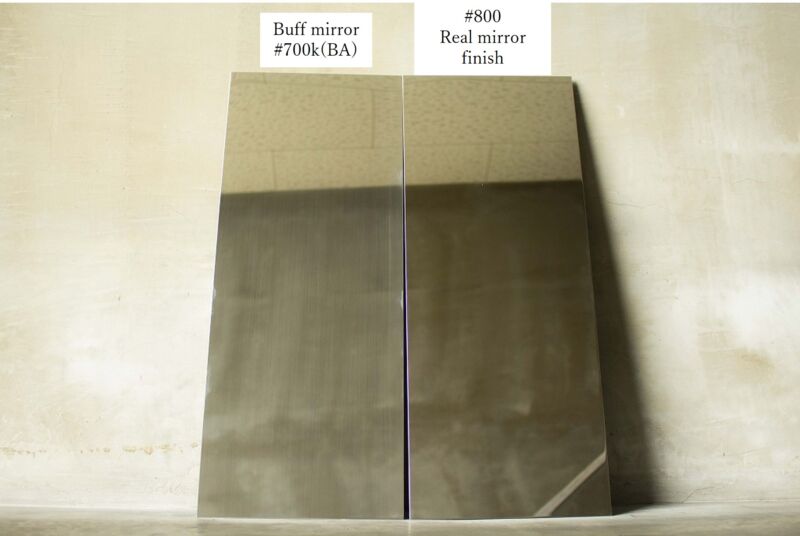
Focus on the diffuse reflection and take a picture of it side by side with the main mirror surface.
There are not as many buffing streaks as with #400 buffing, but you can see a thin buff line.
This diffuse reflection causes the slight whiteness in the photo above.
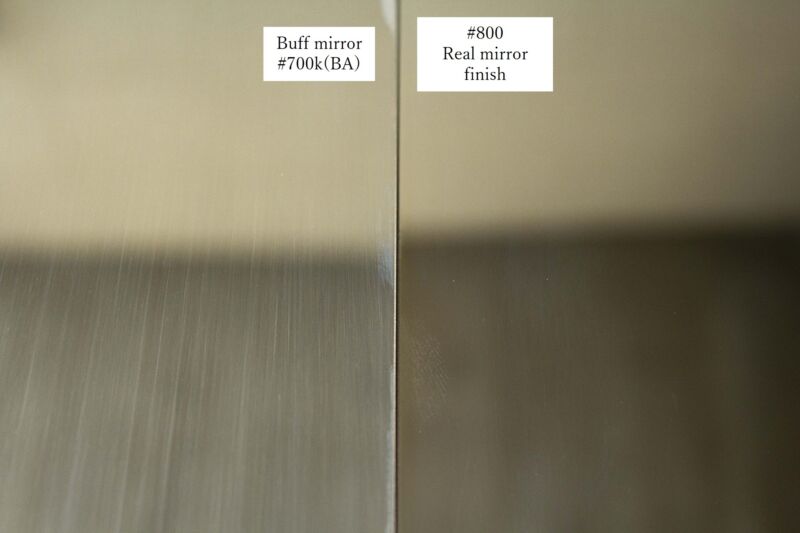
Difference in the appearance of stainless steel mirror by buffing mirror #700K (BA) and #400 buffing
Enlarge the buffing streaks.
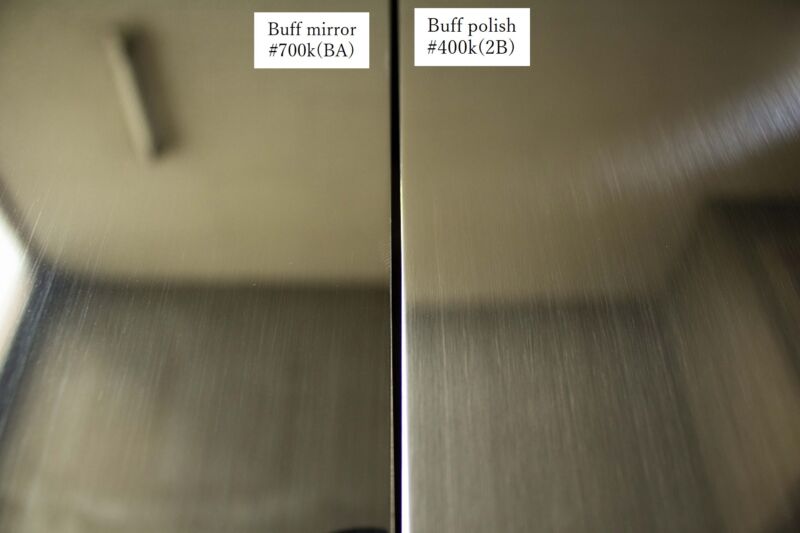
The difference in the density and thickness of these buffing streaks changes the diffuse reflection of light, which changes the way it looks.
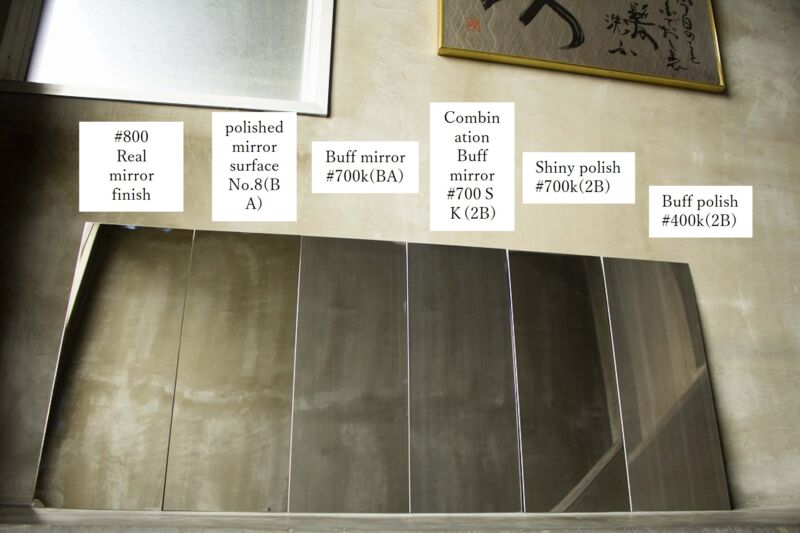
Here’s a slightly angled view of the entire image. Indoors, the white buffing streaks are affecting the color.
Difference in stainless steel mirror reflection
We look at how the stainless steel mirror looks outdoors and how it reflects the surrounding environment, assuming that it will be used in an actual environment.
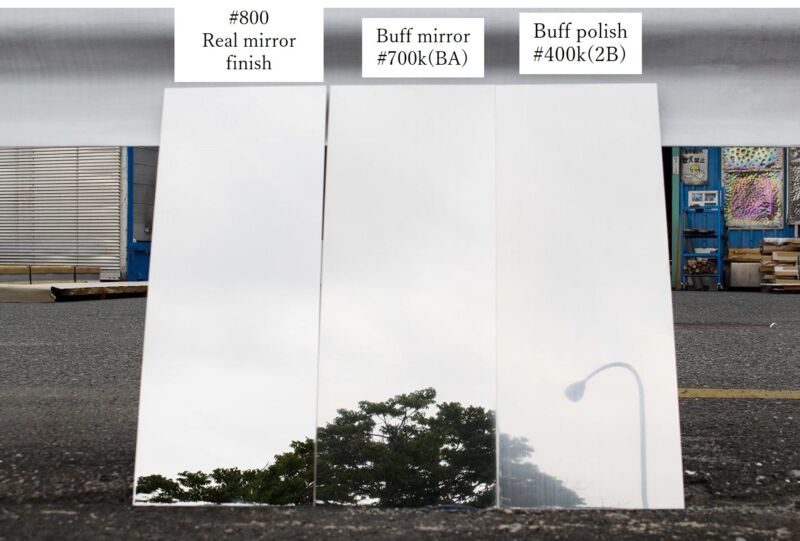
The diffuse reflection of light is especially intense outdoors, and the reflection varies depending on the diffuse reflection of light and the roughness of the stainless steel surface.
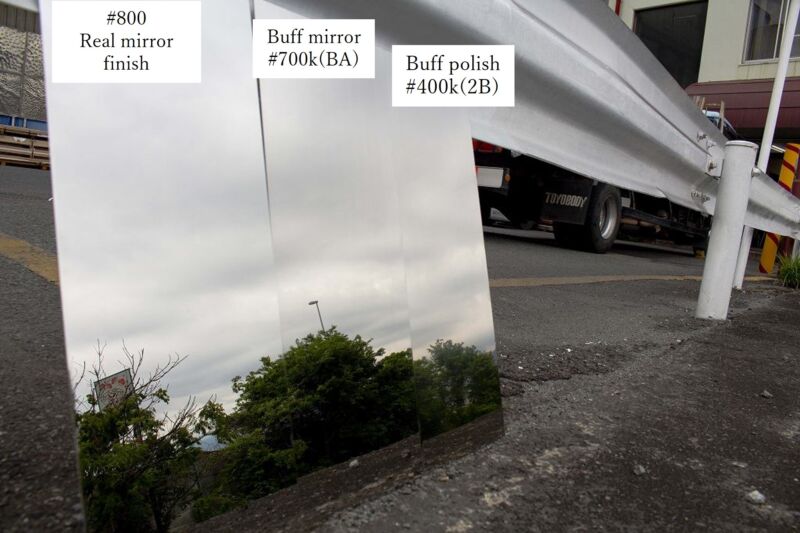
Depending on the angle of view, the reflection changes in this way.
Difference in stainless steel mirror luster
Now, let’s try to quantitatively measure the gloss value.
Numerically, the gloss value decreases when there is a buff line.
(*This is an actual measurement, not a guaranteed value.)
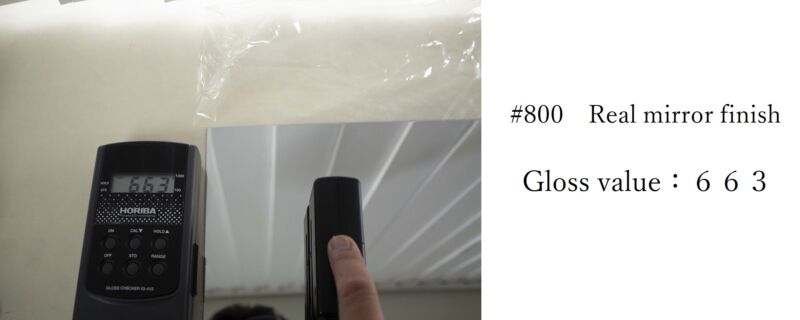
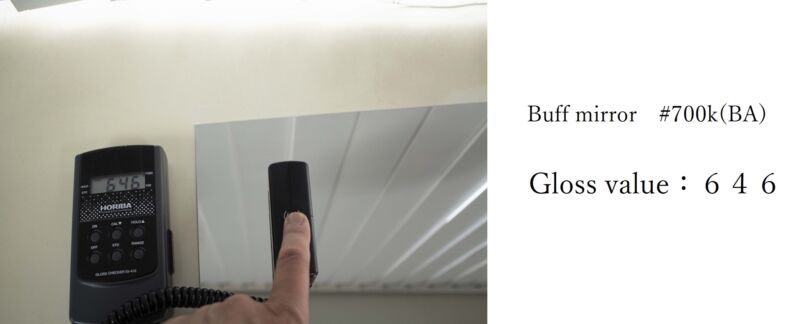
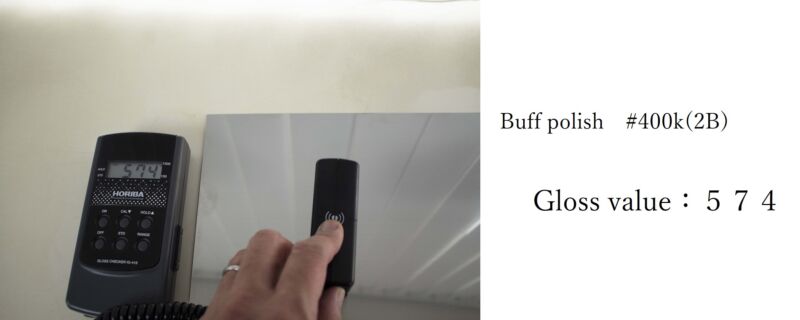
Finally.
Generally speaking, stainless steel mirrors are simply one color.
In the case of hand mirrors and card-shaped mirrors, most of them are purchased ready-made, so there is not much mistake, but we often hear about problems in architectural interior and exterior, equipment, fixtures, artwork, and works of art.
In fact, we receive quite a few consultations throughout the year from people who are troubled by the mirror grade. In this article, we have introduced the basic aspects of grade, quality, and appearance.
The products listed here are manufactured in our company, so please feel free to contact us.
